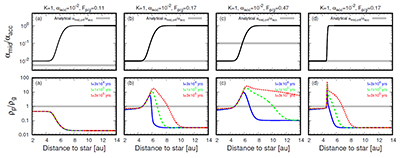A "no-drift" runaway pile-up of pebbles in protoplanetary disks in which midplane turbulence increases with radius
- Details
- Published on 18 January 2021
Vol. 645
1. Letters
A "no-drift" runaway pile-up of pebbles in protoplanetary disks in which midplane turbulence increases with radius

Streaming instability is considered to be a promising way to form planetesimals directly from pebbles in protoplanetary disks, but it requires specific conditions of elevated local solid-to-gas ratios and moderate drag couplings between gas and solids. Several mechanisms have been proposed to locally enhance the spatial density of solids, such as the presence of snow lines and the pile-up of material at pressure maxima produced in different ways. Hyodo et al. present a new mechanism that does not call for snow lines or pressure maxima, but instead relies on the effect of radially increasing mid-plane turbulence. When pebbles drifting from the outer disk enter a dead zone, they experience a decrease in vertical turbulence, reducing their vertical scale height and elevating their concentration in the disk mid-plane. Using both 1D diffusion-advection simulations and analytical arguments, the authors show that for sufficiently large pebble-to-gas mass flux ratios, the gas-pebble friction (back-reaction) causes a decrease in the solids' drift velocity and thus their progressive pile-up, termed "no drift runaway accumulation.” More studies, including additional physical processes, such as Kelvin–Helmholtz and vertical shear instabilities, are needed to gain further insight into the concept.


